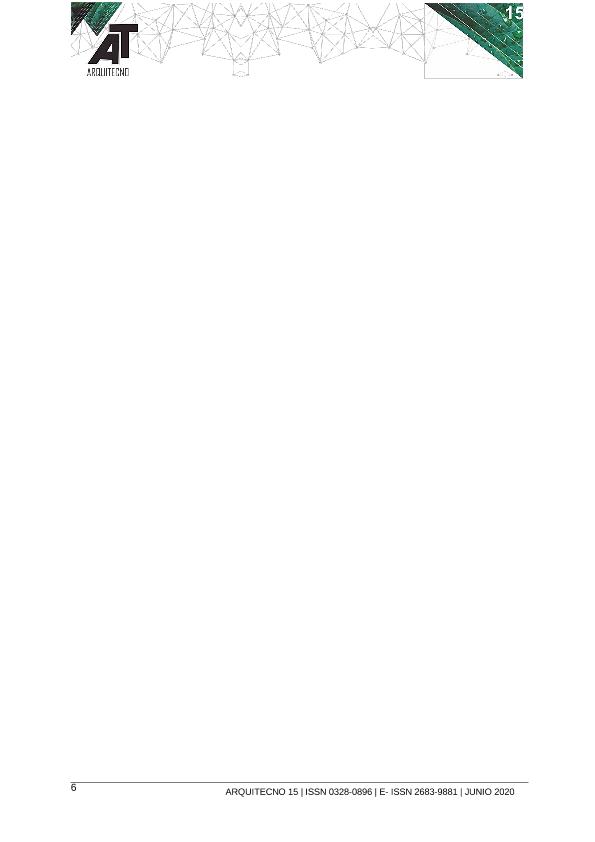Mostrar el registro sencillo del ítem
dc.contributor.author
Suárez Gómez, Pablo Abel

dc.contributor.author
Canton, Maria Alicia

dc.contributor.author
Correa Cantaloube, Erica Norma

dc.date.available
2020-09-03T16:20:02Z
dc.date.issued
2020-06
dc.identifier.citation
Suárez Gómez, Pablo Abel; Canton, Maria Alicia; Correa Cantaloube, Erica Norma; Efecto térmico de fachadas verdes tradicionales en envolventes de viviendas unifamiliares con orientación este: Análisis de casos en el Área Metropolitana de Mendoza; Universidad Nacional de Nordeste Facultad de Arquitectura y Urbanismo; Arquitecno; 15; 6-2020; 7-16
dc.identifier.issn
0328-0896
dc.identifier.uri
http://hdl.handle.net/11336/113128
dc.description.abstract
El fenómeno de consolidación urbana ha limitado el potencial de incorporación de estructuras verdes tradicionales – parques, plazas, arbolado de alineación- surgiendo nuevas formas de vegetación aplicables a las envolventes edilicias: “techos y muros verdes”. El presente trabajo evalúa el impacto de las Fachadas Verdes Tradicionales (FVT), en la condición térmica de edificios de vivienda de la ciudad de Mendoza; cuyo clima es seco desértico (BWk - Köppen-Geiger). Se han monitoreado durante los meses de enero y febrero de 2019, cuatro casos de estudio: dos viviendas con FVT -orientación este- y dos viviendas de igual tipología y materialidad sin FVT (viviendas testigo). Dichas construcciones son del tipo másico, sistema constructivo local más utilizado en la provincia. Se registraron datos de temperatura ambiente exterior e interior; superficial exterior e interior y humedad relativa. Los resultados muestran disminuciones de hasta 3.2 °C en la temperatura ambiente interior de las viviendas con FVT, reducciones de hasta 26.5 °C en muros exteriores y 7 °C en muros interiores. Estas magnitudes avalan el potencial de la aplicación de las FVT para la mitigación del efecto de las altas temperaturas y su potencial para la rehabilitación termo-energética en edificios.
dc.description.abstract
The phenomenon of urban consolidation has limited the potential for incorporating traditional green structures – parks, squares, alignment trees – emerging new forms of vegetation applicable to the enveloping buildings: "green ceilings and walls". This paper assesses the impact of the Traditional Green Facades (FVT), on the thermal condition of housing buildings in the city of Mendoza; whose climate is dry desert (BWk - Koppen-Geiger). Four case studies have been monitored during the months of January and February 2019: two houses with FVT -east orientation - and two homes of equal typology and materiality without FVT (witness housing). These constructions are of the mass type, local construction system most used in the province. Outdoor and indoor ambient temperature data were recorded, surface exterior and interior and relative humidity. The results show decreases of up to 3.2 °C in the indoor ambient temperature of the houses with FVT, reductions of up to 26.5 °C in exterior walls and 7 °C in interior walls. These magnitudes support the potential of the application of PVT for the mitigation of the effect of high temperatures and their potential for thermo-energy rehabilitation in buildings
dc.format
application/pdf
dc.language.iso
spa
dc.publisher
Universidad Nacional de Nordeste Facultad de Arquitectura y Urbanismo
dc.rights
info:eu-repo/semantics/openAccess
dc.rights.uri
https://creativecommons.org/licenses/by-nc-sa/2.5/ar/
dc.subject
EFICIENCIA TERMO-ENERGETICA
dc.subject
SISTEMA DE ENVERDECIMIENTO VERTICAL
dc.subject
CLIMAS ARIDOS
dc.subject
THERMO-ENERGETIC EFFICIENCY
dc.subject
VERTICAL GREENERY SYSTEM
dc.subject
ARID CLIMATES
dc.subject.classification
Otras Ingeniería del Medio Ambiente

dc.subject.classification
Ingeniería del Medio Ambiente

dc.subject.classification
INGENIERÍAS Y TECNOLOGÍAS

dc.title
Efecto térmico de fachadas verdes tradicionales en envolventes de viviendas unifamiliares con orientación este: Análisis de casos en el Área Metropolitana de Mendoza
dc.title
Thermal effect of traditional green façades in unifamiliary housing envelopes with east orientation: Analysis of cases in Metropolitan Area of Mendoza
dc.type
info:eu-repo/semantics/article
dc.type
info:ar-repo/semantics/artículo
dc.type
info:eu-repo/semantics/publishedVersion
dc.date.updated
2020-08-24T18:07:58Z
dc.identifier.eissn
2683-9881
dc.journal.number
15
dc.journal.pagination
7-16
dc.journal.pais
Argentina

dc.description.fil
Fil: Suárez Gómez, Pablo Abel. Consejo Nacional de Investigaciones Científicas y Técnicas. Centro Científico Tecnológico Conicet - Mendoza. Instituto de Ambiente, Hábitat y Energía; Argentina
dc.description.fil
Fil: Canton, Maria Alicia. Consejo Nacional de Investigaciones Científicas y Técnicas. Centro Científico Tecnológico Conicet - Mendoza. Instituto de Ambiente, Hábitat y Energía; Argentina
dc.description.fil
Fil: Correa Cantaloube, Erica Norma. Consejo Nacional de Investigaciones Científicas y Técnicas. Centro Científico Tecnológico Conicet - Mendoza. Instituto de Ambiente, Hábitat y Energía; Argentina
dc.journal.title
Arquitecno
dc.relation.alternativeid
info:eu-repo/semantics/altIdentifier/url/https://revistas.unne.edu.ar/index.php/arq/article/view/4375
dc.relation.alternativeid
info:eu-repo/semantics/altIdentifier/doi/http://dx.doi.org/10.30972/arq.0154375
Archivos asociados
